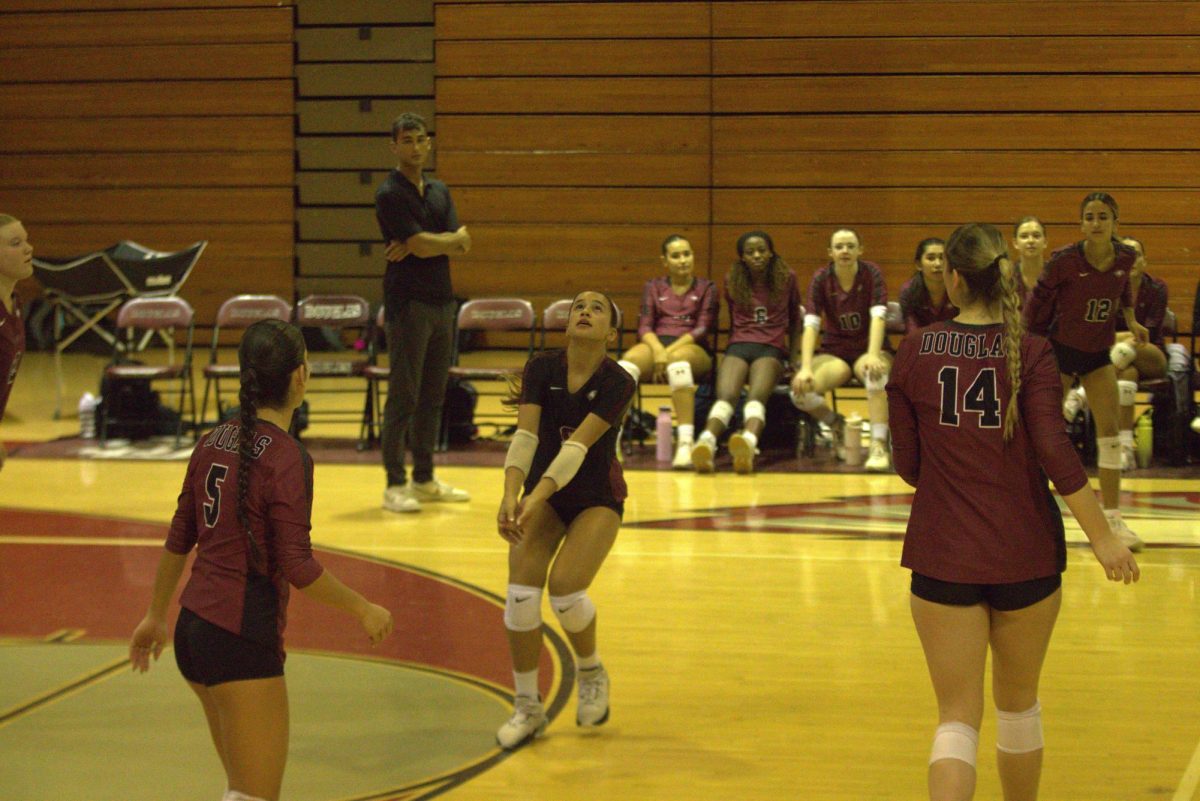Proper nutrition plays vital role in student athletes’ performance
Demetrius Summers (1) charged toward the net through Fort Lauderhill’s defense. Summers’s continuous ability to work his way to the rim provided the team an upper hand throughout the game.
February 13, 2023
She sprinted toward the finish line, legs sore from a challenging run, victory was in her sight. Watching the crowd pass by, she felt like she was soon to be the victor, but then fatigue hit. Watching someone else break the ribbon as her own foot followed just seconds behind, the athlete is left wondering where she went wrong.
One may think that athletic success is determined predominantly by a high sense of motivation, a consistent training schedule or a good coach. While all of these are key components of good athletics, the importance of having satisfactory nutrition is oftentimes both overlooked and underestimated when looking at success. A recent survey of MSD athletes indicated that 56% of student-athletes do not pay attention to the nutritional breakdown of their foods.
Without proper nutrition, an athlete’s body is unable to provide energy to the muscles and organs that allow for functionality. As a result of not being nutritionally equipped to maintain their energy level, their athletic performance will suffer regardless of how much they train.
When examining the nutritional needs of a specific athlete, there are multiple factors to take into account, including how long their energy lasts throughout an athletic event and how well they recover from exercise.
Sports nutritionist and functional dietitian, Barbara Lewin, is an expert on this very subject. For over 30 years, she has worked with high school athletes as well as professional athletes and Olympic contenders to enhance their energy and improve their health.
“I have a lot of clients who are still growing. If they are still going through a growth spurt and they are also training for whatever sport, now you need energy to grow, but you also need energy for your sport, so it is very important to make sure they are getting the right nutrition, and most of the time they are not, and that’s a huge issue,” Lewin said.
According to Lewin, the way in which an athlete recovers from a workout is a good indicator of their general nutritional health. A survey of 85 athletes at MSD reveals that only 33% of student athletes who reported they recover poorly from exercise also pay attention to the nutritional breakdown of the foods they consume. On the other hand, nearly 46% of those student athletes who reported they often or always recover well pay attention to the nutritional breakdown of their foods.
Regardless of activity level, every person requires a wide array of nutrients in order for their body to perform basic functions and maintain energy. High schoolers, especially, tend to require higher calorie counts than adults due to the growth that their bodies undergo as teenagers. When physical activity is added to the equation, the caloric needs of teenagers expand.
According to the National Heart, Lung and Blood Institute, an inactive, teenage boy requires around 2,000 to 2,400 calories per day, while a male student athlete could require anywhere from 2,800 to 4,000 calories per day. The same is true for adolescent girls; those who are inactive require approximately 1,800 calories a day, while female student-athletes require about 2,400 to 3,000.
Not only does nutrition aid in keeping the body healthy, but it also provides the body’s main source of energy. Nutrients are divided into two main categories: micronutrients and macronutrients. Micronutrients are the vitamins and minerals that bodies need small amounts of in order to function. From helping the body fight infection to keeping nerves healthy, vitamins serve a vast array of purposes.
Macronutrients, on the other hand, are what comprise most of one’s diet. Macronutrients include carbohydrates, proteins and fats. Proteins are mainly used by the body to aid growth. They are critical in repairing muscle tissue, making them pivotal for athletes. Fats are required to allow the body to absorb vitamins A, D and E, which are known as “fat-soluble vitamins,” meaning that they only dissolve in fat, and thus can only be absorbed and used alongside fat.
Sports Dietitian Kyndall Herman recommends that student-athletes get between 25% to 30% of their daily calories from healthy fats, 45% to 65% from carbohydrates and consume 1.2-2.0 grams of protein, per kilogram of body weight, per day.
For athletes especially, carbohydrates are highly essential. Foods including pasta, rice, crackers and bread are high in carbohydrates. The body converts carbohydrates into glucose, which is the only form of energy that muscles can use directly. Muscles store glucose from the blood in the form of glycogen, which generally lasts anywhere from 90 to 120 minutes. In addition to providing muscles with energy, carbohydrates also digest quickly, making them further recommended for athletes.
Alternatively, fats and fibers take far longer to digest, which makes it so the body consumes energy while digesting them, rather than giving the individual an immediate excess of energy for game play. Eating foods high in fat and fiber directly before a game can make an athlete feel sluggish or experience cramping during the game. Similarly, ingesting protein requires the body to convert it to carbohydrates in order to provide the muscles with energy in the form of glucose, in a process called gluconeogenesis, which also takes energy from the body. Herman recommends that athletes consume an extra serving of carbohydrates both the night before and the day of athletic competitions in order to ensure their best performance.
“To improve performance, athletes should aim to have a balanced meal three to four hours before competition. Focus on a combination of foods high in carbs and moderate in protein,” Herman said. “Limit foods high in fat and fiber- these will tend to make you feel ‘sluggish’ or cause stomach cramping. Examples include fried chicken–high in fat–or salads–too much fiber.”
In order to ensure ample time for digestion, it is sometimes best not to eat directly before a game, but rather to wait a couple of hours. The majority of MSD student-athletes, 67%, reported consuming their pregame meal one to two hours before their sports game, while 17% reported eating with 30 or fewer minutes left before the game. Only about 14% of student-athletes at MSD reported that they eat their pregame meal within the proper three to four-hour time frame before their game.
Another critical nutrient for athletes is iron. Iron assists the blood in transporting oxygen from the lungs to the rest of the body. When athletes are low on iron, they get winded faster than those who have consumed the necessary amount, which for boys tends to be 11 milligrams per day, and for girls is closer to 15 milligrams per day. About 83% of male athletes and about 89% of female athletes at MSD report having no idea how much iron they consume each day.
While a high carbohydrate and adequate iron consumption are necessary for nearly all athletes, the exact ratios of different nutrients and quantities of daily calories are difficult for experts to standardize, as nutritional requirements are unique for each individual. Dietitians and nutritionists are able to examine individual athletes and determine the precise nutritional requirements of their bodies.
“The best nutrition plan is one that’s individualized, realistic and fits their lifestyle…we come up with a very individualized plan that is not going to work for everyone, but it’ll work for that athlete that I am working with, so it is like their secret weapon,” Lewin said.
About 21% of student-athletes at MSD consult a nutritionist either occasionally or often. From the understanding of their own personal needs, athletes are better equipped to give their best performance.
“How you eat during the week, before your game and how you train during the week [influences performance most],” freshman soccer player Anthony Carnuccio said. “Probably once a month, I go over my diet. I wanted to go full-in on soccer and do my best… I feel like I’m faster.”
MSD athletes who understand the value of nutrition, either from their nutritionist or their own research, tend to establish their own dietary routines which they follow leading up to a sports game.
“If I am low on carbs, then that means I am low on energy, and that means I won’t perform as well,” sophomore football player and wrestler Oshri Gur said. “I wake up, probably make two eggs, eat them, then come to school and eat lunch. Normally I pack some chicken or salmon with some rice and eat that. Then I go, and we have our pregame meal for football. Then I chill for an hour or two in the locker room, and we go and we play.”According to Lewin, another frequent problem faced by athletes is managing their diet during their off season. Since the majority of sports do not run year-round, athletes who only engage in high levels of physical activity during their season need to make adjustments to their diet when they are inactive. Despite this, 51.8% of MSD students report making no change to their diet when their sport is not in season.
Lewin reports having seen many cases of athletes becoming out of shape during off seasons because they continue to consume the same number of calories that they are used to while using fewer due to a decreased activity level. Herman recommendation, athletes decrease their carbohydrate increase from half of their plate during game season, to one-third of their plate during the off season.
“With the grind of the season behind you, the off-season is the perfect time to focus on your eating habits and make changes to your body composition, if this is a goal of yours,” Herman said. “You can do this by picking a couple habits you’d like to improve during this time—for example, focus on drinking more water, eating breakfast daily or limiting fast food. It is important that you rest, recover and enjoy the downtime, while also allowing yourself some flexibility with your eating,but remember to always keep your offseason training goals in mind.”
According to health experts, nutrition is one of the most influential components of being successful in athleticism. By ensuring that their intake of each nutrient is sufficient for fulfilling their body’s individual needs, student-athletes are able to perform better during games, recover faster after exercise and reduce athletic hindrances such as fatigue. When nutrition is prioritized at the same level that physical training and practice are, sports nutritionists find that athletic performance only improves.
This story was originally published in the February 2023 Eagle Eye print edition.











